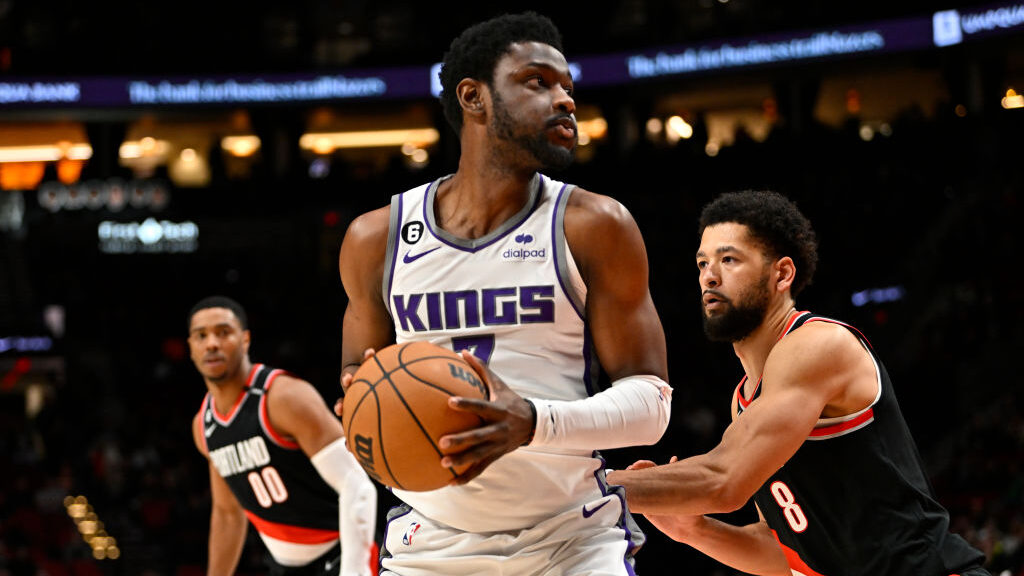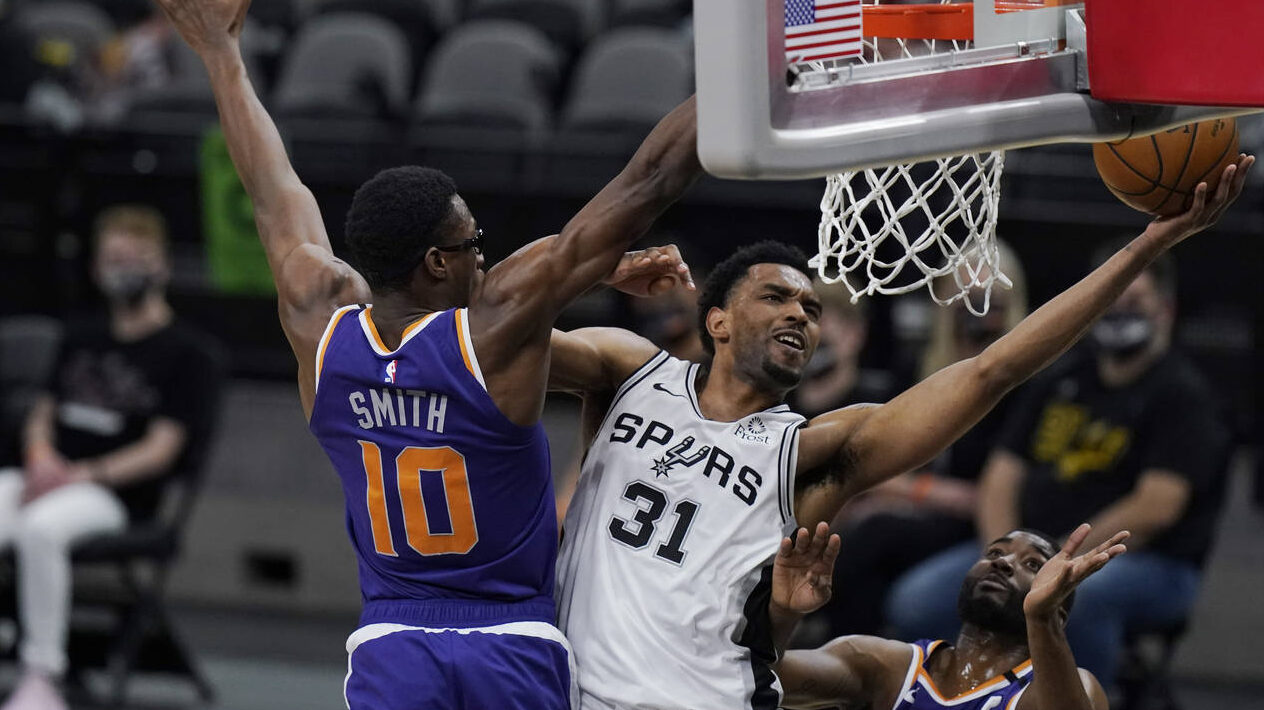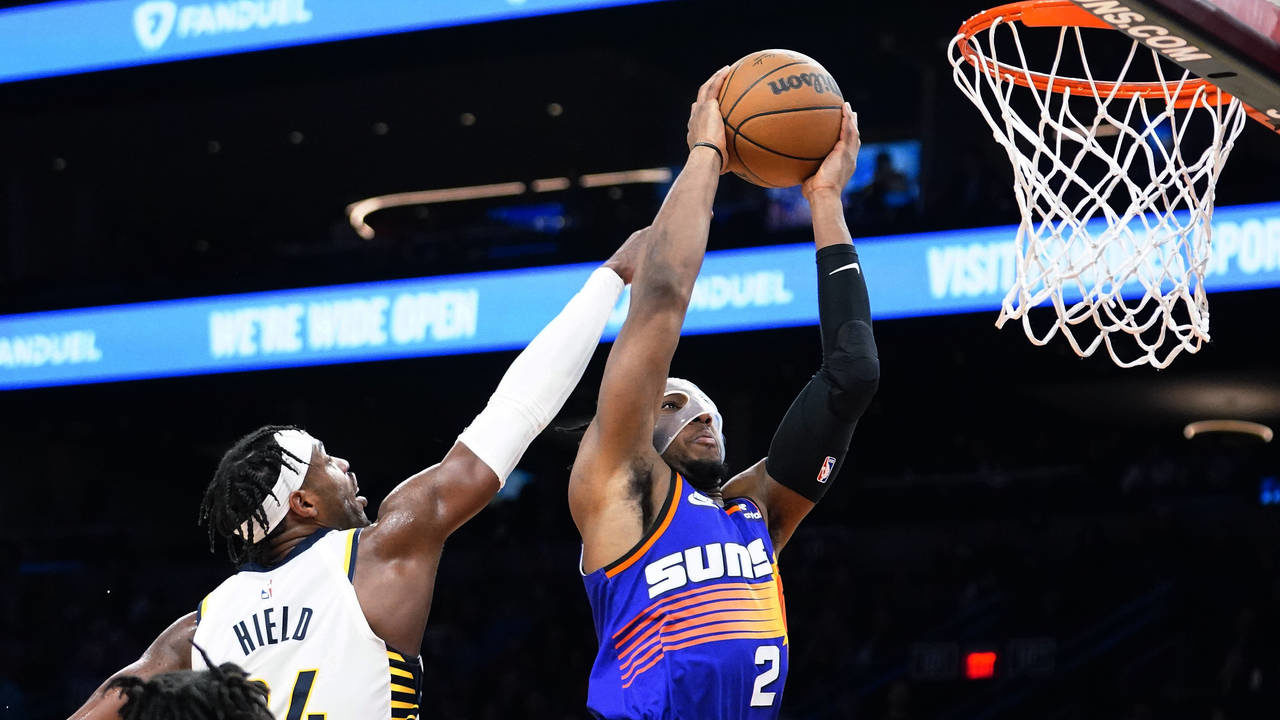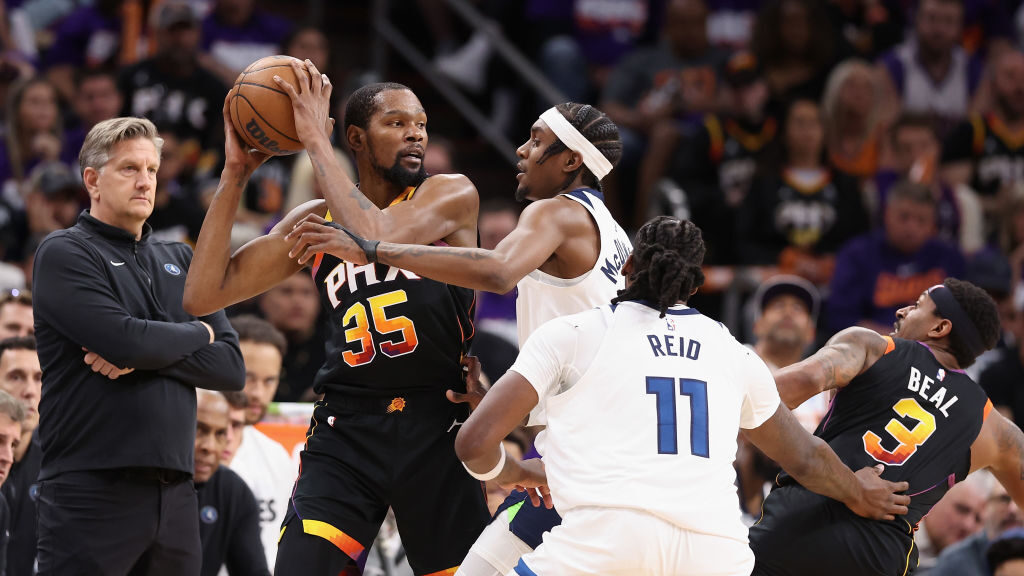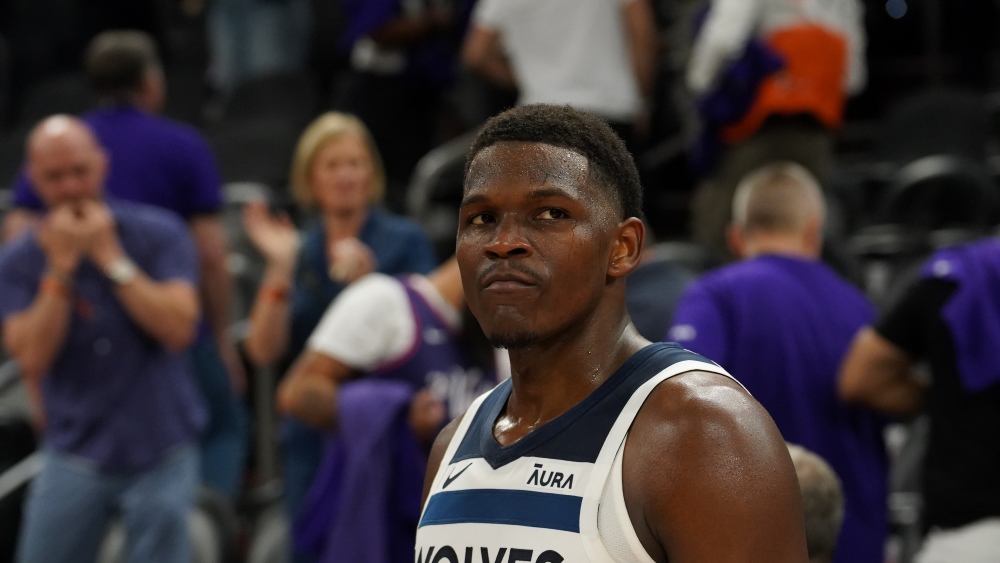Phoenix Suns’ impressive flurry of signings balances out bench
Jun 30, 2023, 6:55 PM | Updated: Jul 1, 2023, 7:50 am

The Phoenix Suns just shopped like my dad. Coupons and checklist in tow, executed with ruthless efficiency. In and out within 15 minutes. No questions were asked in the direction of a store employee. He already knows what he wants and needs. If anything is to be vocalized, it’s muttering to himself about how slow the checkout line is.
Phoenix’s two-hour version of the same efficiency at the beginning of free agency filled in six roster spots and almost the entire roster. It agreed to terms with Keita Bates-Diop, Drew Eubanks, Damion Lee, Chimezie Metu, Josh Okogie and Yuta Watanabe, all on the veteran’s minimum contracts the Suns could only afford to offer.
Their intent was clear. Get more athletic, younger and locate more positional versatility on defense for new head coach Frank Vogel. Don’t forget about shooting, either. That too.
Players like Bates-Diop, Metu, Okogie, Watanabe, Toumani Camara, Jordan Goodwin, Isaiah Todd and Ish Wainright can all play multiple spots due to their length and speed. That’s over half the roster! Before getting to Bradley Beal, Devin Booker and Kevin Durant!
If Camara is on a two-way contract, which is possible for a guy who was the 52nd pick in this year’s draft, Phoenix has one roster spot left. If the Suns use a traditional spot on him, they emptied the shelves. All 15 spots, donezo.
Let’s break down all six signings before returning back to the overall picture. Take a few deep breaths. We got some ground to cover.
Okogie, one of two returnees to recap, was the biggest surprise of the day. A glut of absences beginning in December gave him the opportunity for legitimate playing time and he ran with it from there. After the trade deadline, Okogie was third in total minutes for the Suns, and with good reason.
In those last 26 games in a big role, he averaged 11.0 points, 4.3 rebounds, 1.9 assists and 1.2 steals per game while shooting 37.3% from 3 on 4.5 attempts a night. Okogie provided terrific defense, especially at the point of attack, tremendously helping Phoenix fill the Mikal Bridges-sized hole on that end. He showed a good feel for 0.5 situations as a cutter and passer while also serving as the resident maniac on the offensive glass.
Okogie’s shortcomings, however, came to the surface in the postseason. Denver started games in the second round with Nikola Jokic defending Okogie and would go to it in crunch time, throwing a wrench in the ways Phoenix wanted to attack. Okogie’s improvements with shooting and decision-making didn’t carry over as well, so that led to him falling out of the rotation altogether.
Still, this is a guy who was legitimately good on a great team whenever he got the chance to be in the regular season and was just coming off taking the minimum last offseason. There had to be some teams out there willing to pay him more, but Okogie ultimately chose a safe landing spot where he will compete for a sizable role.
It’s easy to forget he’s turning 25 later this summer and can still grow more as a player for Phoenix.
Lee was the lone vet to immediately return, and he always made sense to. The 30-year-old finished third in 3-point percentage (44.5%) among players with at least 200 attempts and made timely shots in the fourth quarter all year.
In the playoffs, he proved (through a strangely inconsistent role) that he can impact games beyond knocking down shots. Lee plays extremely hard and is smart, which both go a long way for a shooter that has his own gravity.
3 plays w/ Damion Lee showing his value.
— Baseline to corner, Okogie screens and Mann has to stay. DA lob.
— Could have pulled up as the "shooter" needing 1 but makes the right basketball play to keep it moving. Booker 3.
— Hyland recovers back to the corner. CP3 middy. pic.twitter.com/pmsOAzTi05
— Kellan Olson (@KellanOlson) April 23, 2023
Lee shot 0-for-5 in a Game 2 loss to the Nuggets but was still a net positive thanks in large part to his hustle that included six rebounds and a pair of assists.
What he will do is grant Vogel some wiggle room in that aforementioned vision of what the Suns’ supporting cast becomes. If the offensive spacing just isn’t good enough from the athletic defenders, Lee comes in and will punish any defense that helps off of him. He already proved last year that spotty appearances will not phase the approach or change his effectiveness. Again, it feels like he could have taken more money elsewhere, so a credit to the Suns’ ecosystem on that front.
All four newcomers are coming off their best NBA seasons, something to consider when factoring in the Suns signing them all to the minimum somehow. They all could have waited for paydays to emerge but decided to take the best basketball opportunity.
The guy out of these six has the highest chance to be a big factor come April and beyond is Bates-Diop.
Bates-Diop was the Big Ten Player of the Year in his junior year at Ohio State, and given his physical profile as a forward (6-foot-8, 7-foot-3 wingspan), received a fair share of hype as a potential first-round pick. Bates-Diop, however, slipped in the draft down to 48th overall, which sort of indicated the direction his NBA career was heading before it started.
He spent one-and-a-half years with the Minnesota Timberwolves ahead of a brief stay in Denver before playing for the San Antonio Spurs the last three seasons. It never really clicked for the 27-year-old until last year.
Head coach Gregg Popovich was asked about Bates-Diop toward the end of the season.
“He’s carving out an NBA career,” Popovich said. “From the beginning, it didn’t look like that but he’s worked on his skills, his confidence, his aggressiveness, everything. Really proud of him.”
Bates-Diop by no means set the world on fire but 9.7 points, 3.7 rebounds and 1.5 assists per game with good defense was a breakthrough.
The dude is simply gigantic with those long arms, given how well he moves his feet.
The biggest development was Bates-Diop upping his 3-point attempts from a total of 72 in his first two Spurs seasons to 142 and converting on 39.4% of ’em.
It’s one year and not a high volume but a positive step forward. His shooting motion has some build-up to it. He will have time for it due to who he will share the floor with.
He shot 43% from the corners specifically, 69% at the rim and is a solid passer to boot.
If that overall 3P% holds on double the attempts and Bates-Diop’s defense translates to a winner, the Suns will somehow have unearthed an effective 3-and-D wing on the minimum, an accomplishment previously thought of to be impossible. Even if it’s not quite that, the size on defense will help regardless.
Watanabe is a similar player to Lee, just a bit bigger on the wing at 6-foot-9. He was one of the best shooters in basketball last year, 44% on 3s and a ridiculous 52% in the corners with the Brooklyn Nets.
Sporting News’ Steph Noh picked up on changes in Watanabe’s mechanics the 28-year-old found in Brooklyn compared to his NBA start in 2018. No more hop or dropping the ball down. Cash.
Both of these Yuta Watanabe videos are slowed down 50%. Compare the first shot he ever took to last night. Release is so much faster.
This man put in WORK to go from a 12% shooter to 57%. pic.twitter.com/8eZDJcUyzR
— Steph Noh (@StephNoh) November 21, 2022
Kevin Durant played with Watanabe last year and praised him on his podcast, The ETCs via Boardroom. Durant commended how hard Watanabe plays and works at his shot, joking but not really joking that he feels the need to tell Watanabe to slow down so he doesn’t hurt himself flying around the floor.
“His jump shot looking solid right now because his fundamentals look perfect on that joint,” Durant said in November.
Durant would get mad at Watanabe whenever he didn’t shoot. That is what he will be in Phoenix as well. There’s some slight trepidation since he hasn’t stuck anywhere yet and his playing time faded with the Nets, but having someone like Watanabe in the forward rotation is a no-brainer.
The center position for Phoenix will be all about the dirty work, so that explains the Eubanks fit already. While it is a lot of what Jock Landale was doing, the interpretation can be Phoenix feels better about how Eubanks does it.
Like Landale, his motor never stops and he’s pin-balling off everyone. Some tidbits from The Athletic’s Jason Quick:
“He’s got some nasty in him that I loooove,’’ coach Chauncey Billups said. “He’s getting in a dustup almost every game with somebody. He’s one of those guys that people probably hate playing against, and it’s only because he is competing very hard.’’
“Once I got better at basketball, I just always kept that nasty, that ‘don’t-touch-me attitude,’” Eubanks, 26, said. “I didn’t like being pushed around then. I didn’t like being pushed around in college. And I don’t like being pushed around here.”
That energy on the rim runs is combined with Eubanks’ really good screening and his efficiency makes him an effective offensive piece. Eubanks shot 75% at the rim and 54% in the short midrange, per Cleaning the Glass. The latter is where it’s about floaters and hook shots, an area starting center Deandre Ayton is very good in as well.
Defensively, Eubanks will hang in there more than expected and is a solid rim protector but longer stints is where Eubanks’ foot speed can start to get exposed a bit. As a backup center, it’s more than fine and he can still get better. Another get that’s awesome value on the minimum.
Metu, 26, is a player that has attempted to become more dynamic than that by adding a 3-point shot, ultimately not getting it to stick. That’s a shame because he is a pretty great athlete who also suffers from some tweener stuff since he lacks too much agility-wise to be a 4 and doesn’t have enough size (6-foot-9) to be a 5.
He sure is explosive.
Metu was a great 76% finisher at the rim, per Cleaning the Glass. He’s got some progress left to make before becoming an effective defender and that’s where you hope Vogel can work his magic.
Alright! Those are the new basketball players! A depth chart check-in, you say, for final evaluations? Sure!
PG: Booker, Payne
SG: Beal, Goodwin, Lee
SF: Okogie, Bates-Diop, Wainright, Todd
PF: Durant, Watanabe, Camara
C: Ayton, Eubanks, Metu
From a depth perspective with the spot the Suns were in, they couldn’t have done much better.
The only other ball-handler outside the Big 3 is Cam Payne, so he becomes an important part of this, even if he doesn’t crack the initial rotation. That’s honestly fine because this whole thing hinges on the trio staying healthy anyway, and Vogel will ensure that at least two of them are on the court at all times in big games.
The fifth starter didn’t become a sure-fire guy but that was always a pipe dream. Bates-Diop, Goodwin, Okogie, Wainright and Watanabe could all theoretically win that job over the course of the season. Maybe even Camara if his shot is consistent and his defense has instantaneous impact.
Eubanks and Metu filling out the big rotation points toward some small-ball lineups in the future, at least far more than we saw for the Suns under Monty Williams. Pretty much everyone just mentioned as a fifth starter possibility could also scale down a position or two. Get ready for Durant at the 5.
To that end, it’s a lot of defensive skillsets for Vogel’s specialties to fine-tune. Bates-Diop, Goodwin and Okogie is a nice haul outside of his stars, before even getting to Camara and Wainright.
The ultimate question to be proposed at the end of July was if it would be enough of a supporting cast, knowing the roster construction shortcomings in front of the Suns.
We didn’t even need to wait until the end of June to say yes.



